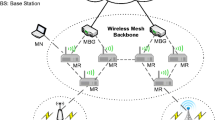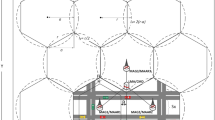Abstract
Currently existing IP mobility management protocols deploy a centralized anchor to manage mobility of the mobile nodes in both control- and data-planes. As a result the data traffic and mobility control signaling for all the mobile nodes registered in the network are handled by the centralized mobility anchor. Considering the ever increasing number of mobile users and mobile data traffic volume, the centralized mobility management approach presents performance drawbacks, such as low scalability, traffic bottleneck, and single point of failure. Furthermore, this approach causes non-optimal routing and creates significant delays on packets, especially when the two communicating nodes are close to each other yet far from the mobility anchor. However, mobility management schemes developed based on a distributed mobility management (DMM) approach can overcome these limitations. In this paper, we present a network-based DMM scheme which eliminates the drawbacks of the centralized mobility management approach such as the traffic bottlenecks and single point of failure. Furthermore, our proposed scheme optimizes the route for ongoing mobile node communication(s), such that both handover and newly established communications are optimally routed. Analytical and simulation results show that the proposed schemes yield a significant improvement with respect to the currently proposed DMM schemes—in terms of reducing packet delivery cost, tunneling cost, and total cost as well as end-to-end packet delivery delay and handover delay.















Similar content being viewed by others
References
Perkins, C., Jonson, D., & Arkko, J. (2011). Mobility support in IPV6. IETF RFC 6275.
Gundavelli, S., Leung, K., Devarapalli, V., Chowdhury, K., & Patil, B. (2008). Proxy mobileIPv6. IETF RFC 5213.
Chan, H., Liu, D., Seite, P., Yokota, H., & Korhonen, J. (2013). Requirements for distributed mobility management. IETF draft-ietf-dmm-requirements-11 (work in progress).
Ernest, P. P., Chan, H. A., & Falowo, O. E. (2012). Distributed mobility management scheme with mobility routing function at the gateways. In Proceedings of IEEE GLOBECOM (pp. 5254–5259).
3GPPTS 23.002. (2011). Network architecture. V10.1.1, release 10.
WimaX forum. http://www.wimaxforum.org/.
Chan, H. A. (2012). Distributed mobility management with mobile IP. In Proceedings of IEEE ICC (pp. 6850–6854).
Wakikawa, R., Valadon, G., & Murai, J. (2006). Migrating home agents towards internet-scale mobility deployments. In Proceedings of ACM Conference on Future Networking Technologies (CoNEXT’06).
Nguyen, T. T., & Bonnet, C. (2013). DMM-based inter-domain mobility support for proxy mobile IPv6. In Proceedings of IEEE WCNC (pp. 1998–2003). Shangai, China.
Giust, F., De La Oliva, A., Bernardos, C. J., & Da Costa, R. P. F. (2011). A network-based localized mobility solution for distributed mobility management. In Proceedings of 14th International Symposium on Wireless Personal Multimedia Communications (WPMC) (pp. 1–5).
Crawford, M., & Haberman, B. (2006). IPv6 node information queries. IETF RFC 4620.
Costa, R., Melia, T., Munaretto, D., & Zorzi, M. (2012). When mobile networks meet content delivery networks: Challenges and opportunities. In Proceedings of Seventh ACM International Workshop on Mobility in the Evolving Internet Architecture (pp. 11–16).
Lee, J.-H., Gundavelli, S., & Chung, T.-M. (2009). A performance analysis on route optimization for proxy mobile IPv6. In Proceedings of IEEE ICC (pp. 1–6).
Lee, J.-H., Han, Y.-H., Gundavelli, S., & Chung, T.-M. (2009). A comparative performance analysis on Hierarchical Mobile IPv6, and Proxy Mobile IPv6. Telecommunication Systems, 41, 279–292.
Akyildiz, I. F., & Wang, W. (2002). A dynamic location management scheme for next-generation multitier PCS systems. IEEE Transactions on Wireless Communications, 1(1), 178–189.
Makaya, C., & Pierre, S. (2008). An analytical framework for performance evaluation of IPv6-based mobility management protocols. IEEE Transactions on Wireless Communications, 7(3), 972–983.
Xie, J., & Akyildiz, I. F. (2002). A novel distributed dynamic location management scheme for minimizing signaling costs in Mobile IP. IEEE Transactions on Mobile Computing, 1(3), 163–175.
Lee, J.-H., Ernst, T., & Chung, T.-M. (2010). Cost analysis of IP mobility management protocols for consumer mobile devices. IEEE Transactions on Consumer Electronics, 56(2), 1010–1017.
NS-2 Network simulator. http://www.isi.edu/nsnam/ns.
PMIPv6 for NS-2 patch and required packages. http://commani.net/pmip6ns/download.html.
Nascimento, A., Sofia, R., Condeixa, T., & Sargento, S. (2012). A decoupling approach for distributed mobility management. In Proceedings of 21st International Conference on Computer Communications and Networks (ICCCN) (pp. 1–6).
Bertin, P., Bonjour, S., & Bonnin, J.-M. (2008). A distributed dynamic mobility management scheme designed for flat IP architectures. In Proceedings of 3rd International Conference on New Technologies, Mobility and Security (NTMS) (pp. 1–5).
Giust, F., de la Oliva, A., & Bernardos, C. J. (2011). Flat access and mobility architecture: An IPv6 distributed client mobility management solution. In Proceedings of IEEE Conference on Computer Communications Workshops (INFOCOM WKSHPS) (pp. 361–366).
Fischer, M., Andersen, F.-U., Kopsel, A., Schafer, G., & Schlager, M. (2008). A distributed IP mobility approach for 3G SAE. In Proceedings of IEEE PIMRC (pp. 1–6).
Author information
Authors and Affiliations
Corresponding author
Rights and permissions
About this article
Cite this article
Ernest, P.P., Chan, H.A., Falowo, O.E. et al. Distributed Mobility Management with Distributed Routing Management at Access Routers for Network-Based Mobility Support. Wireless Pers Commun 84, 181–205 (2015). https://doi.org/10.1007/s11277-015-2602-0
Published:
Issue Date:
DOI: https://doi.org/10.1007/s11277-015-2602-0




